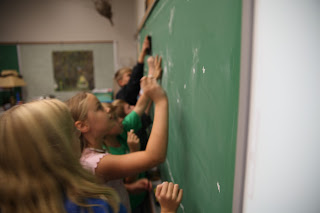Here, Sam writes a wonderfully descriptive account of the experience:
Sometime the week before, I had been assured that simply by being in my History of Animation class the particular day Tiny Circus was presenting, that I was automatically a member of Tiny Circus. I didn’t feel that way. I was not hoping to go into film school, like many of the other members of my class. I was just a computer science student who needed a humanity and liked cartoons. Still, I was looking forward to getting to be a part of the process of animation. I knew it was a tedious process, but I had no idea until I got to see it in action. Two whole classrooms of students were split into four groups. Each group would then go to a station and work on a task related to animation there, switching every thirty minutes or so.
 |
| EEE Students set-up animation stations to shoot Ghost Trap! |
The students at the non-chalkboard animation station had to move more slowly and deliberately. They did their animation on what is essentially a table with a camera and lights on the top of it. The camera on this contraption was also controlled by a laptop. Each student was assigned a star, and had to move it a small amount. I participated in this process for a small bit, and found it quite tedious, and soon had to move on to something else. I later found out that using this method, it took fifteen minutes to create all of three seconds of animation. I find it amazing that Tiny Circus could hold on to the attention of so many children for so long, and have them collaborate to make something original. Judging by the animation of theirs that I have seen, they are quite good at this.
 |
| Animating the night sky |
The last station was sound. Here students were encouraged to make their own sound effects for the animation using whatever materials they could find in the room they were in, though they mostly used their own bodies and voices to create sound. I learned about this often-forgotten part of filmmaking, such as the idea that it’s best to have a three-second pause between sound effects to make them easier to separate for the sound editor.
 |
| A group of students record sound effects for a chase scene |











